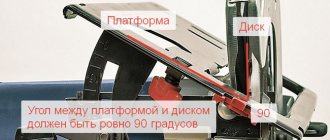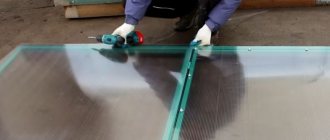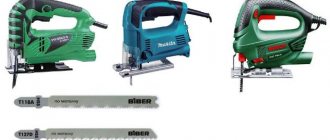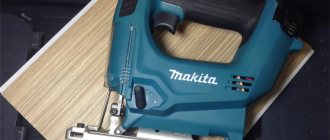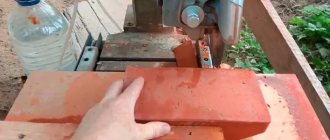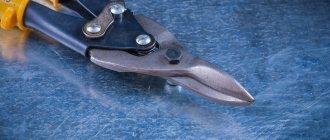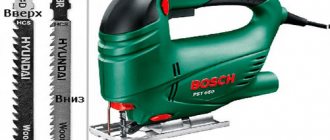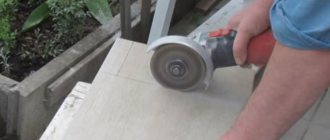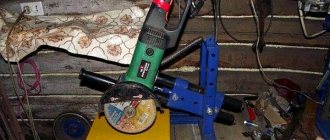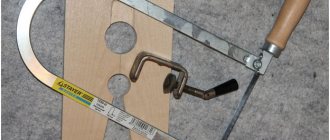How to choose the right wheels
There are signs on the circle that will help you choose the right circle.
When choosing disks, you need to know why they will be used and pay attention to their diameter and thickness. These are the main characteristics of the disks.
The smaller diameter is 100 20 5 mm, and the largest publicly available is two hundred 50 mm. In professional grinding machines, the discs can be larger in diameter.
The thickness of the cut part and the greatest cutting depth depend on the diameter of the disk.
If you only plan to cut metal, you will need to purchase a cutting disc. It has a thinner thickness of one to 1.2 mm, suitable for industrial grinding machines. up to 2.5 mm. This will ease the physical stress of the grinder and the worker. The cut is careful.
If you are planning a figured thread on narrow metal, then this is done with a disk of smaller diameter or an old, almost worn-out disk.
Many people think that they should use a diamond blade to cut metal. This is a completely wrong worldview. Diamond
the disc will simply get stuck in the metal and will be unsuitable for the work ahead.
Experts say that even beginners do not have any particular difficulties when cutting metal with a grinder.
Main categories of diamond blades
In addition to the properties of the binder, the type of cutting edge largely influences the scope of application of the equipment. According to this parameter, diamond blades are divided into:
- segmented discs
- designed for dry cutting and provide maximum productivity. Found among diamond discs for concrete; - solid discs
- allow you to achieve maximum cutting quality; water cooling is often required for effective operation. Found among diamond discs for porcelain stoneware and marble; - turbo discs
- have notches on the cutting surface and are distinguished by their versatility; - turbo segment disks
- combine the features of segment and turbo disks.
When selecting diamond blades, it is also important to consider the compatibility of the tool with the equipment. It is determined mainly by the size of the circle and the operating speed.
How to choose the right grinder
The grinder should lie comfortably in your hand.
The correct choice and quality of the grinder itself determines the quality of work and the safety of the worker.
When choosing a machine, you should control its main parameters: power and diameter of the cutting abrasive wheel. Its weight is also important, because you often have to work “on weight” and dimensions so that you can do work in awkward and inaccessible places.
When they see massive grinders, most buyers are somewhat frightened that it is more difficult to cope with them than with a low-power one. It's a delusion. Low-power grinders often jam the discs, i.e. At the physical level, they cannot “pull out” the disk under enormous loads. The situation of how the disk and the machine itself will behave after the load is reduced is unpredictable. Most likely, the grinder will be snatched from your hands. The consequence of this will be disk failure, machine failure and cutter injury. Therefore, it is better for novice craftsmen to purchase a grinder for a 100 20 5 mm disc with a power of 800-1000 W and a spindle speed of 10,000 rpm. This force is enough to cut iron.
disc -mounted machines for cutting metal
100 fifteen mm powered by batteries, but, as practice shows, they do not justify themselves due to their overhead when solving everyday problems.
The handles of the coffee grinder should be rubber or made of a material that will dampen vibrations of the machine.
But none of the technical features reflects convenience and safety in operation. The grinding machine should fit comfortably and firmly in your hand, so that when working with metal you focus on it, and not on how to hold the tool in your hands. It is better that the handles are made of rubber or vibration-isolating material with grooves for the fingers.
Low-power grinders usually do not have an additional handle.
If any inconveniences were found during the selection, you should look for an angle grinder of a different model.
How to properly cut metal with a grinder. Practical tips and advice
If long pipes rest on supports, you need to cut off the protruding edge. If you cut them in the center, the metal will bend under its own weight and jam the disk.
If you do not have the ability to use a grinder, then before work you should learn how to cut unnecessary parts.
The cutting disc only accepts circular forces. Trying to change the cutting plane while the blade is inside the iron part will break.
The heel of the blade (near the bottom of the circle) cuts metal more effectively.
In order for the grinder and discs to serve for a long time, every 5-7 minutes of work it is necessary to take a break of 20-30 minutes. This rule is especially important for low-power angle grinders who are afraid of overheating.
To increase the service life of discs, especially expensive ones, and to cool the metal, the cut area should be watered with water. It is better to carry out the work together.
Aluminum. very strong metal. When cutting a piece of large thickness, you need to drip kerosene into the seam, observing fire safety rules.
For forming, cutting sheet metal, and shaped carvings, worn discs should be used. “stubs”, so don’t throw them away right away.
It is correct to cut off the corner not at once, but separately both shelves.
If there are rather long pipes, angles, or fittings lying on the supports, carefully trim the overhanging edge. If you cut between the supports, the part will bend under its own weight and jam the disk.
Thick parts are cut only in straight strips. If it is necessary to cut out a shaped part, first straight cuts are made, then the remaining unnecessary parts are removed.
You should not put pressure on the grinder. This will lead to jamming or breakage of the disc and overheating of the angle grinder. If the cutting process is slow, you should change the blade.
The purchased cut should not be processed with the side of the disc. For this, a different type of disk is used.
Melted particles of metal and abrasive, falling on plastic products, glass and car headlights, get stuck in them, and then it is virtually impossible to remove them. Therefore, before work they need to be removed or protected.
How to cut metal using a grinder
There is a worldview that the very concept of “grinder” has entered our everyday life, since this instrument was first brought from Bulgaria. This is partly true. But they developed and began to create in Germany. For the first time it came to us from Bulgaria, where it began to be created in the 70s. Angle grinder. correct name of the instrument.
When working with an angle grinder, be sure to follow safety precautions, namely: wear glasses, gloves, a helmet and a protective apron.
The acquired areas can be sanded, sanded, or sharpened. A large selection of interchangeable attachments makes this tool irreplaceable and versatile.
At the same time, it is a more traumatic instrument.
For cutting metal with a grinder you will need:
- Mask;
- Glasses;
- Discs;
- Bulgarian;
- Metal.
What are the sizes of wheels for angle grinders Bosch, Interskol and more?
The size of the circle determines which grinder it is suitable for and what kind of work such a tool can perform. The smallest size is 100 mm. It is suitable for small grinders and is used exclusively for processing small-sized parts.
Large grinders with the largest circle size of 300 mm. used for cutting bricks, fittings, pipes of almost any diameter.
Important! You cannot put larger discs on the grinder than those indicated in the instructions for using the tool. This will make working with an angle grinder dangerous.. Angle grinder (grinder) Makita GA 5030
Photo VseInstruments.ru
Angle grinder (grinder) Makita GA 5030. Photo VseInstruments.ru
Circle sizes for the most popular brands of grinders:
- 115 mm. – Bosch GWS 7-115 E, Bosch GWS 1000.
- 125 – Makita GA5030, Bosch GWS 7-125, Metabo WEV 10-125 Quick, Bosch GWS 14-125 Inox.
- 150 – Metabo WE 14-150 Plus, Sparky MB 1600CPA.
- 180 – Makita GA7020, Bosch GWS 22-180 LVI, Metabo W 24-180.
- 230 – DeWALT D28401, Bosch GWS 20-230 H, Makita GA 9020 (GA9020.
Outer and bore diameter, minimum and maximum values
The seat diameter is standard for all types of circles and is 22.2 mm. The external size according to the standard is divided into 5 types, each of which is designed for its own work:
- 115 mm. – ideal for the smallest jobs.
- 125 is the most popular size for home use.
- 150 – suitable for various types of work.
- 180 – used for capital construction work, but it will be too small for cutting red brick.
- 230 – used for cutting pipes of any diameter and performing the most voluminous work.
Angle grinder Metabo WEPBA 19-180 QUICK RT with a disc with a diameter of 180 mm. Photo VseInstruments.ru
There are also non-standard sizes.
For large, medium and small angle grinders
Large angle grinder AEG WS 2200-230DMS. Photo VseInstruments.ru
The larger the grinder, the larger the diameter of the circle you can put on it. There are three types of angle grinders:
- small: circle no more than 125 mm, low power consumption;
- medium: 150 mm;
- large: 180-230 mm.
There are also micro-grinders that can accommodate discs with a diameter of up to 70 mm. This tool can be used to perform jewelry work.
For metal, concrete, wood and other materials
The size of the disk used also depends on the material that is supposed to be processed.
For metal, electrocorundum and crystalline corundum discs of all sizes are used, depending on what exactly needs to be cut. Small ones can cut sheet metal, and large-diameter circles can cut heating pipes and stainless steel.
Silicon carbide wheels are made for cutting concrete and stone.
We advise you to study - How to choose curtains for your interior
To cut ceramic tiles, a metal disc with diamond chips is used.
Cutting, diamond and others
Diamond wheel DEWALT DT3735XJ. Photo 220Volt
Cutting discs are used for cutting tiles, bricks, paving stones, and slate.
Diamond wheels are designed for dry, wet cutting, and there are also universal ones.
Diamond consumables for dry cutting are available in all known sizes. Such a tool can heat up when sawing, so it is necessary to take a break every 2 minutes during the work process. This way you can cut granite.
The wet cutting disc must be moistened with water. Universal ones can work with any type of stone, both dry and wet cutting.
Basic rules for safe work when cutting metal with an angle grinder
Scheme of more unsafe sectors when working with an angle grinder, taking into account rebound and destruction of the disc.
The most necessary condition for a haircut. serious adherence to safe work rules.
Manufacturers of grinding machines are constantly trying to minimize the risk of injuries and injuries by inventing and improving various protection systems. But no one bothers about the worker like he himself.
The main threats that arise when cutting metal. this is the flight of fragments of a broken disk, a stream of sparks and small abrasive particles, the inability to hold the tool in your hands.
If the disk breaks or jams, the angle grinder can break out of your hands at the most inopportune moment and with great force, therefore, even before starting work, you should predict the direction of its likely movement.
Safety rules cannot be ignored even when performing small jobs.
Before work you should:
- Protect your face, eyes, hands and all parts of your body as much as possible.
- Remove all flammable materials and objects that are in the direction of sparks.
- Secure the part being processed with an angle grinder in a vice as best you can. Do not hold the workpiece with your free hand or press with your foot.
- If you install a new disk, you need to “unwind” it with a grinder at the highest speed, placing it further away: the disk may be defective and fly apart.
- Install, adjust and secure the protective cover.
It is best to protect your face with a special shield when working with an angle grinder.
READ Is it possible to slaughter an uncastrated boar?
During work you should:
- When replacing disks during rest, you need to disconnect the angle grinder from the network.
- Use goggles or a face mask to protect your eyes and face. masters use both for long-term work.
- Hold the grinder firmly during all work.
- To change the disk, you must wait until it stops completely.
- Wear protective gloves. There is no need to use cotton gloves, they do not provide sufficient protection, they can catch fire, and the threads can wrap around the grinder spindle or disc.
- During work, you must position yourself so that your face, and if possible, all parts of your body, are not in the plane of rotation of the disk.
Upon completion of work you should:
- Wait until the rotation of the disk has completely stopped and only then place the tool on the floor with the disk facing upward so as not to destroy it;
- Disconnect the angle grinder from the network;
- Make sure there is no smoke or other signs of fire.
A common mistake made when cutting metal: if the diameter of the new circle is larger than the size of the protective casing, it is removed. Casing. protection against breakage and splitting of the disc during metal cutting.
Instead of a disk, many people use cutters, saws or other improvised material. This is strictly prohibited.
Is it possible to use a grinder for cutting metal tiles and corrugated sheets?
At that time, when they just started using metal tiles and corrugated sheets, the annotation stated that using a grinder to cut these roofing materials was strictly prohibited. This is explained by the fact that on both sides they are protected with zinc and polymer coatings and painted.
The abrasive disc heats and melts the material. Sections are torn. Floating sparks will also destroy paint. All this causes corrosion of the material and a reduction in service life.
However, in the near future, builders began to use an angle grinder for this work. This greatly simplifies the work; it can be carried out directly on the roof. After trimming, the edges must be treated with anti-corrosion agents, primed and painted.
metal correctly
It's not difficult to use a grinder. Everything can be found out. Main. observe safety rules and follow advice.
Is it possible to cut metal with a grinder with a diamond blade?
- Build blocks
- Build boards
- Mortars
- Build lessons
Are they universal?
of diamond blade is better suited for a certain range of tasks. You can, of course, try to work with them as a universal device, but this will lead to a decrease in efficiency, accelerated wear and an increased risk of injury.
Let's look at the main types of diamond blades:
Review of diamond blades for tiles and concrete. Cutting clay and paving slabs with a grinder
Diamond blades for tiles and concrete. Diamond tool review and test for cutting clay and paving slabs.
Solid disc.
This type is perfect for working with ceramics or marble. Thanks to the rigid shape of the disc, an even cut is ensured, which allows you to work with decorative materials. On the one hand, the hard drive requires forced cooling (it is widely practiced to cut “in a puddle”), on the other. while ensuring high-quality cooling, there are no restrictions on the duration of continuous operation.
To work with particularly tough materials, it is recommended to use special discs with oblique splines (splines). They reduce lateral friction, reducing disc heat and helping to remove dust.
This disc has the option to cut EVERYTHING! One disc = sixty abrasive wheels. Innovation in metal processing
Universal wheels for grinders: ?? FREE Drywall Maintenance Course:
Solid disc.
This type is comfortable for working with ceramics, in other words, marble. Thanks to the rigid shape of the disc, an even cut is ensured, which allows you to work with decorative materials. The positive point is that a solid disk requires forced cooling (cutting “in a puddle” is widely practiced), and in addition. while ensuring high-quality cooling, there are no restrictions on the duration of continuous operation.
To work with particularly tough materials, it is recommended to use special discs with inclined splines (splines). They reduce lateral friction, reducing disc heat and helping to remove dust.
Are they universal?
of diamond
blade is better suited for a certain range of tasks.
You can, of course, experience working with it as a universal device, but this will lead to a decrease in efficiency, accelerated wear and increased injuries. Let's look at the main types of diamond blades:
Feature of diamond blades
Diamond blades occupy a special place among all cutting tools. Their main feature. presence of diamond coating. Technologies for its implementation may be different, but the effect of spraying is virtually always the same: the service life of the disk, cutting accuracy and cutting cleanliness increase sharply. In addition, the list of materials on which you can work is significantly expanding.
For example, a medium abrasive disc is very inconvenient for cutting ceramics, natural stone or good concrete. Diamond blades are excellent at cutting these materials.
Basically, discs of this type are designed to work with non-metallic materials, but there are special modifications for metals. But you should take into account what to cut
Metal with such discs can only be done “in a straight line”. Diamond blades are ideal for:
- Ceramics;
- Glass;
- All types of stone;
- Brick;
- Concrete and reinforced concrete.
Combined disc.
It can be used for cutting any non-metallic material, but clay tiles should be cut with water, and concrete can be cut without cooling. The disadvantage of this type of disk. low efficiency compared to the variations listed above.
Will a stone disc cut iron the same way as its metal counterpart?
Imagine that you need to saw something, but there is no disk for this. There is a disk for other material and there is no place to get the “correct” one soon. Bye-bye the store will open or the required disc you ordered will arrive from the online store... You can die of boredom...
Fortunately, such a situation has never happened to me, I keep track of the supply of necessary disks and support it, but suddenly someone has an old woman with a leak and he doesn’t know what to do.
And in order to calm the anxiously restless souls, I took and carried out another test in which I simulated two situations: you need to saw metal, but there is only a disc for stone-concrete, and you need to saw stone-concrete, but the disc is only for metal. So let's cut and compare...
All photos: author
What do we saw with?
We cut with two “ Luga-Abrasive”
“.
Both are 115mm
.
One of them is for stone-concrete (green) and the second is for metal (blue). The thickness of green is 2
mm, but the thickness of blue is
1.8
mm. The difference is explained by the fact that the store did not have discs for metal 2 mm and for stone-concrete 1.8 mm. But, I think, these two dozen will not play a role, tea is not twice the difference...
What are we sawing?
First, we cut the square profile 20x20x1.5, already familiar to us from previous disk tests. Same for 10
cuts. We measure the remaining diameters of both disks, draw conclusions and share our impressions. And then we cut 200x150 tiles, two cuts at a time, directly on the wall, which, although not quite stone-concrete, is a material quite close in spirit.
Of course, this is not a millimeter disk that was cut by the same profile like a knife. But here he was in his element and the metal was sawed the way it should be sawed. There is no problem with sparks, but, according to the “Luga” tradition, there were a lot of them, but the stench was... it was specific...
Residual diameter – 109 mm.
Not bad, if you remember the test results of the same 1 and 1.2 mm disks (there were 98 and 108 mm, respectively). This makes you wonder whether it would be more profitable to take thicker discs. Moreover, they can already be used to clean up, albeit without fanaticism...
Of course, on metal, the disc went more difficult on stone-concrete. However, he coped with his task of sawing material that was unusual for him quite adequately and sawed everything without falling apart, scattering, or smoking. In terms of sparks... probably his sparks were richer, denser...
Residual diameter – 107 mm.
Agree that compared to its metal brother it looks very decent. Those. it can be considered suitable for working with metal, but it will be a little... more expensive.
Now we're moving to tiles
Don’t be surprised, but this tile is condemned to demolition and therefore it was not a pity. By the way, I laid it myself 22 years ago. And it didn’t collapse... Hey...
I didn’t cut with new disks, but finished with the same two. Here, as you understand, it was important not to show the exact wear figure, but to find out on what material how each of the disks will behave in principle...
Tile: disc on stone-concrete
The order has changed because because. Like its brother, I made two cuts with a green disk (visible in the photo in the background). One seemed to me not enough (for disk wear in the sense), but two - just right. It was cut as usual (and I sawed a lot of tiles in my time), nothing new. There was dust, of course... As always...
Residual diameter – 101 mm
.
Only 6 mm was ground off, i.e. – 5.6
% of 107 mm. And I’m not at all surprised, because... green “Lugi” are precisely intended for sawing such materials. True, diamond ones are better for tiles, but I once got along well without them. And then I bought a diamond one.
Externally, during sawing there were no such nuances. The blue disc sawed the same way as the green one, the same amount of dust, the same effort, everything was equal, as expected... But! There is a small “but”... Wear and tear!
Residual diameter – 91 mm (!!!).
And this is after 109 mm.
Loss of as much as 16.5%
out of the blue under the same conditions! Those. The performance of the metal disc when working on tiles is three times less than that of its counterpart. Devastation!!! This is what it means to use a disc on the wrong material!
conclusions
I am more than sure that directly on stone and concrete the results of the blue disc will be even worse. Still, tile is a more homogeneous material than concrete, and not as solidly durable as stone.
However, this is not the main thing, but the fact that both disks are not interchangeable
. Those. If you cut metal with a disc on stone-concrete still back and forth, then it’s better not to waste the metal disc on tiles and concrete with stones. Only if it’s a very, very last resort... That’s a very last resort...
Links to past disk tests:
- For some reason, we don’t like “Luga-Abrasive” discs. I compare them with Bosch, Hitachi and DeWalt
- For some reason, we don’t like “Luga-Abraziv” discs (part.2). Against them: Cutop, Hitachi and DeWalt
- What should you be afraid of if the cutting disc of an angle grinder is damp?
- What happens if you moisten cutting discs with water and... cognac
- A grinder with a special disc or a circular saw – which is better?
News
Like all other tools, grinders are divided into classes, into professional and household tools, also according to design features.
This is perhaps the most widely used tool besides the drill. Many people work with angle grinders, but not everyone asks about the correctness of the manipulations performed, from the point of view of personal safety and quality of work. In this article, we want to dedicate you to the main intricacies of working with this tool and will consider in detail the following questions:
Let's go in order.
HOW TO CUT BULGARIA CORRECTLY?
Before you start working, you need to prepare the grinder. This refers to the choice of equipment (disk). The following points should be taken into account:
- Disc diameter. Remember that the smaller the diameter of the disc, the more revolutions (higher rotation speed) it can withstand, and vice versa.
- The choice of disk depends primarily on the material you plan to work with and the design features of your tool.
- Pay special attention to the legend and markings on the disc. By carefully studying them, you will understand whether the selected equipment is suitable for the proposed job.
Also, always use safety precautions and wear appropriate equipment such as gloves, goggles, long-sleeved gowns, and closed shoes.
First of all, clear your work area of unnecessary items. Securely secure the workpiece, marking it on it first if necessary. Beginning.
Always hold the instrument firmly and firmly with both hands. Take a stable body position. You need to stand so that sparks do not fly onto your clothes and especially into your face while working.
Always remember the concept of return. This is the most dangerous thing that can happen when working with an angle grinder. This can happen if the blade is pressed tightly into the workpiece. In such a situation, the grinder will sharply throw you back. Follow the process to avoid this.
Also remember that the power cord of the angle grinder must be insulated from sparks falling on it during operation
. If you need to move the tool to another work surface, be sure to turn it off first and then unplug the power cord. The same should be done in case of a power outage. As soon as the power goes out, turn off the tool and then unplug it. If this is not done, then when the power supply is restored, the angle grinder will again begin to work in chaotic mode and can cause irreparable harm to your health, those around you, or damage objects around you.
The most frequently asked question that arises among novice craftsmen is the following: How to cut correctly with a grinder: for yourself or for yourself? Many people do not attach much importance to this, but in vain.
Bulgarian manufacturers advise their consumers the following: You need to work with the tool so that the cutting stroke (direction) coincides with the direction of rotation of the disk.
Experienced craftsmen have a clear answer to this question: you need to cut it out of yourself. This is for your safety. If the grinder is snatched from your hands, the tool will be thrown in the opposite direction from you. If you hit yourself when the above situation occurs, the tool will fly to your feet. We will not describe the consequences. You can imagine them yourself.
READ How to Insert Brushes into a Grinder
If you are cutting parts or workpieces with thick metal, cut them exclusively straight.
When working on a piece such as a corner, cutting a profile or profile pipe, which is usually quite long, cut off the overhanging edge. Otherwise, if you make a slot in the place between the supports, such an outcome as jamming of the disk due to deflection of the workpiece is possible.
If you are cutting corrugated board (sheet metal), metal siding (metal siding) or metal tiles, make sure you have special anti-corrosion products that need to be lubricated to prevent sudden corrosion.
If you are cutting paving slabs or paving stones, purchase a special diamond cutting disc.
Reinforced concrete, concrete and other similar materials must be processed with special stone discs.
If you need to cut a gas or oxygen cylinder, be very careful as it may explode due to the remaining trace of gas or condensation. It is better not to do this kind of work at home.
If you need to cut glass or, for example, a mirror. The most trivial ceramic disc will suit you.
When working with a material such as corrugated slate, do not use extra force to avoid chipping and unevenness.
You can treat rubber with a grinder, but it is not necessary. If you understand what we mean.
Grooves, springs, fittings or channels can also be cut using angle grinders.
Need to cut drywall or polycarbonate? Do this very carefully so as not to chip or break the material. You will need to be careful when cutting glass mosaics. For example, if you are cutting off excess parts from a glued-on arch, cover the cut and cut portion with masking tape or construction tape. This minimizes the possibility of cracks and prevents debris from being thrown onto the floor after cutting.
HOW TO CUT BULGARIAN TILES WITHOUT CHIPS?
As we said above, the scope of application of angle grinders is incredibly wide. It is also an excellent tool when cutting materials such as tiles or tiles. But regarding the equipment, a logical question arises: what is the best way to work with tiles? To carry out this type of work you will need a diamond grinding wheel and a tile stand. It is unlikely that you will be able to work with this material without dust, so take care of a protective mask in advance.
Let's take a closer look at the process itself and how to cut tiles or tiles without chipping.
- The easiest way. cut straight. Fasten the tile well so that its edge remains suspended along the mowing line for bevelling the cut, and get to work.
- The next method is worth paying attention to. This is a forty-five° angle cut. This method is more difficult than the first. First, we cut the ceramic tiles with a straight cut. Then, when cutting, we direct the grinder disk at an angle and remove the excess part. Next, sand the cut with sandpaper.
HOW TO CUT BULGARIAN METAL
?
First, let's talk about the dangers that await craftsmen when cutting metal with a grinder, namely:
- Disk fragments in case of failure;
- Powerful stream of sparks and small abrasive particles;
- In some cases, it is impossible to hold the instrument in your hands.
And now some tips for working with metal.
If you do not have experience in this type, then first you should practice on unnecessary parts. If during work you decide to change the cutting plane when the disk is inside the workpiece, this will immediately lead to its failure.
To increase the service life of disks, especially expensive ones, they need to be cooled. This is done with water. It is necessary to water the cut area. It is advisable that you work with a Partner who will carry out all these additional manipulations.
Also, breaks of 5-7 minutes every 20-30 minutes of work will help increase the service life of both the equipment and the tool itself. This rule is especially important when working with household grinders. This will protect your instrument from overheating.
You should also remember that you cannot put pressure on the angle grinder while working, otherwise it may fail due to overheating, or the disk may jam. If you feel the performance is too slow, try changing the drive.
IS IT POSSIBLE FOR A BULGARIAN TO CUT A TREE?
Many experienced craftsmen say that cutting wood with a grinder. it can not be. Our opinion: indeed, you can cut wood with an angle grinder, but it is extremely unsafe, inconvenient, slow and of poor quality. And therefore.
Firstly, the sanding disc gets very hot during operation and becomes incredibly brittle. The slightest displacement can lead to disc rupture. You can learn about the consequences of the current situation from pictures on the Internet.
Secondly, when working with a disk equipped with winning solders, these solders can easily get under the skin. And this is a direct route to the hospital, because you won’t be able to remove them yourself, plus everything is fraught with infection.
Third, when using a blade on wood, the teeth may grab more wood than you expect, which in turn will cause this to happen. That the grinder will simply break out of your hands. It is very dangerous!
We hope we've explained in an understandable way why you can't use angle grinders when working on wood, and you won't even try.
But, as practice shows, many craftsmen at home resort to using an angle grinder when processing materials such as chipboard, chipboard, laminate, OSB or plywood. This must be cut as carefully as possible and in compliance with all safety measures. Otherwise, you can not only damage the material, but also get injured.
HOW TO CUT BULGARIAN ACCURATELY?
In order not to spoil the workpiece and make a high-quality, even cut with a grinder, you will need to perform a number of preparatory measures, which we will talk about in this part of the article.
- Marking. Everything ingenious is simple. First we mark, then we cut. Let's take pipe cutting, for example. First, mark the size with chalk or marker, then use paper or tape. The main thing is that the edge is smooth. We take the selected auxiliary material and carefully wrap the pipe with it. Its boundary will be a clear and precise marking of the cut. When performing work, it is important to remember that under no circumstances should you change the position of the tool. Otherwise, the disc may get stuck or break. Also, you should not put additional pressure on the tool, as this will immediately affect the curvature of the cut and ruin your workpiece.
- It is very important to choose the right thickness of the circle. A simple axiom applies here: the thicker the material you are working with, the thicker the disc
. When choosing a tool, consult with a specialist in the field and pay attention to the markings on the grinding wheel on its jacket.
HOW TO CUT BULGARIA SAFELY?
Working as a grinder. a matter that requires constant attention and control, because the consequences of accidents are irreversible. Therefore, before starting work, take care of the following:
- Take care to protect all parts of the body: face, hands, eyes.
- Clear the work area of clutter, especially the area where sparks fly, and remove all flammable materials.
- The workpiece must always be securely fastened.
- Be sure to install the protective cover.
- Hold the tool firmly while working .
- At the end of the work, wait until the rotation of the disk has completely stopped, place the grinder with the disk facing up so as not to damage it, disconnect the tool from the power supply and make sure there is no smoke or signs of fire.
WHAT CANNOT BE CUT BULGARIAN? BASIC ERRORS
The list below contains materials that you can work with with an angle grinder. It is prohibited to work with materials that are not on the list.
- LBM will do an excellent job of cutting materials such as cast iron, metal, steel, copper, aluminum, iron, titanium. Can cut stainless steel or galvanized steel.
- With the appropriate attachments you can also work on plastic, ceramic, glass, plexiglass and porcelain.
- Stone, granite, marble, asphalt, concrete or a wall made of it, brick, porcelain stoneware can also be processed with a grinding machine.
An angle grinder comes in handy when cutting water pipes or old heating.
One of the main factors guaranteeing quality of work is the correct choice of tools. If you have any questions or would like to purchase discs, please contact our managers at the telephone numbers provided. They will recommend suitable disks and advise on all questions of interest.
READ Scissors for a screwdriver for cutting metal
What you need to know about diamond blades.
Manufacturing
So how are diamond blades made? Let's try to figure it out.
Pieces of artificial diamond are pressed into a metal binder at special companies. Diamonds of different qualities and sizes and various metal binders are used.
By changing the quality of diamonds, concentration, binder composition and shape, diamond segments of the desired grade can be obtained.
The segments are attached to the steel body by laser welding (for dry cutting) or silver soldering (for wet cutting).
Melting of silver occurs at a temperature of 650-700°C, which allows the use of high quality diamond segments). Now the cutting part resembles a blank, but it does not yet have cutting properties.
Successful manufacturers have developed a new technology for fastening HDS (high density sintred) - high-density powder soldering. HDS allows you to use high quality segments. Discs made using this technology can be used for dry processing. The new soldering method does not require a neutral zone between the segments and the body, which allows 100% use of the segments (cutting part). The label of such discs bears the mark With HDS technology. To achieve the cutting effect, the disc segments are ground (opened) with a ceramic sharpener to such a depth that the first pieces of diamond become visible.
The diamond blade is now ready for use. The factory opening direction of the diamond blade determines the position of the blade on the shaft of the cutting machine. Some companies act correctly by marking the correct direction of rotation of the disk with an arrow on its body.
How to choose
To select the right blade, you need to know what size, tooth shape and brand are suitable for the machine you are using and the material being processed.
The outer diameter of the disc depends on the desired cutting depth: the greater the cutting depth, the larger the diameter. In this case, it is necessary to take into account the diameter provided for the machine used. If the outside diameter specified for the machine is not suitable for the job being performed, you need to get another machine. Under no circumstances should you change the diameter of the disk provided for the machine, since the linear speed of the disk will be incorrect - depending on the material, the cutter will either wear out incorrectly or become stuck and overheat, and there is also a danger of overloading the machine.
The internal hole of the disk must be selected according to the machine shaft; in no case should there be a gap. The difference in diameters can be corrected by precise selection of washers.
The most common internal hole standards are:
|
Shape selection
The shape of the teeth of a diamond blade depends on the purpose and material being processed. The speed and cleanliness of cutting depends on the shape of the teeth. For example, to cut asphalt, the distance between the teeth must be large so that the crumbs are removed well, and the cleanliness of the cut does not matter in the case of road surfaces.
Discs for cutting clinker tiles and glass do not have teeth, since a clean cut is needed and there is a danger of damaging the material.
It is a common belief that high housing tooth segments increase blade durability. This is wrong. Strength depends on the composition of the binder of the segment and the concentration of diamond. High segments are used primarily for cutting stone materials to ensure there is sufficient distance to the pliable bond for the segment to wear and to prevent the blade from getting stuck.
Primary marking
If you have to cut various materials from stone, you should choose discs of universal brands, but if the material is known in advance, then it is more economical to choose discs of special brands.
It should be noted that different companies use different methods, designations or symbols for marking, so when choosing a disk you need to be very careful, otherwise cutting can be very expensive.
Often users judge too primitively, dividing processed stone materials into two types - soft, easy to process, and hard, difficult to process.
For hard stone, use a disc with a soft binder, and for soft stone, use a hard binder. But this is not always enough, since there are also soft stone materials, the processing of which can be much more difficult than hard ones.
One of the main signs is the abrasiveness of the stone material. Thus, when choosing a disc brand, it is necessary to divide stone materials, first according to the degree of abrasiveness, into three groups and then according to hardness.
|
Error correction
What happens if the wrong brand of disc is used?
If the binder is too hard, the segment (cutting part) will get stuck. This will also happen if the brand is correct, but the car is pressed too hard.
Sign: the disc begins to cut more slowly, the segment is polished - the cutting surface has become smooth. In this case, you cannot continue cutting, much less press harder.
Solution: cut an abrasive material such as fireclay or a ceramic sharpener for a while until the cutting surface becomes lumpy again (this is called opening the segments). If the cutter constantly gets stuck, you need to choose a softer brand of disc.
If you continue to work with a stuck cutter, the polished diamond will overheat (turn blue) and eventually turn into graphite. The cutter body will also overheat and become deformed (the disk will “throw” from side to side). This situation cannot be corrected and the disc will have to be thrown away.
Segment (cutting part) - wears out too quickly if the grade is too soft for this material.
Sign: the disc cuts very aggressively, and the segment (cutting part) wears out during the first meters of cutting so much that it is noticeable to the eye.
Another sign: things are getting to the point where the sides of the segment (although the segment still has sufficient height) become the same height as the thickness of the body, and the disk begins to jam in the material.
If you continue to work with such a blade, cutting will be too expensive or the cutter will wear so incorrectly that you will have to stop working anyway.
Solution: you need to use a harder brand of disc. The soft blade will remain for cutting harder materials.
Which disc to choose for wet or dry cutting?
A disk for dry cutting (with laser welding) is also suitable for wet cutting (if operating conditions of the machine allow), nothing special will happen to it. No dust will be generated, but cutting speed and blade life will be reduced. And yet, while continuing to work, you should under no circumstances use water for cooling from time to time. Sudden cooling leads to disk deformation. This can also happen accidentally, for example, when cutting asphalt covered with puddles of water.
Wet cutting blades typically have a larger diameter than dry cutting blades. Wet cutting blades require careful water cooling to keep the body temperature within acceptable limits. The crumbs should be carefully removed from the depth of the cut.
Dry cutting cannot be done with discs for wet cutting; segments soldered with silver may fall off the body (silver solder melts at a temperature of +650-700°C), and the steel body may overheat (it will lose its rigidity and the cutter will begin to wobble).
Tips for diamond blade users
When purchasing a new blade, you need to find out: what material composition is to be cut; what is the cutting depth; What size diamond blade is suitable for the machine being used (outer diameter, thickness, inner hole); what is the power of the cutting machine in kilowatts; whether wet or dry cutting will be used (machine capabilities). The seller needs this information.
If the disk was purchased previously, you need to make sure that its brand matches the material being cut. If in doubt, it would be better to consult the seller or supplier. When installing the disk into the machine, you must ensure that the direction of rotation of the disk, indicated by the arrow on the cutter, coincides with the direction of rotation of the machine shaft.
It is also important that the machine speed matches those marked on the cutter. On the label, the manufacturer indicates the maximum permitted rotation speed (rpm) and maximum linear speed (m/s).
Working at the wrong speed can damage or wear the cutter incorrectly and result in ineffective cutting. Avoid tilting the cutter to the sides and using force (the weight of the machine is sufficient). For large cutting depths, it is more correct to make a preliminary cut (20% of the final cutting depth). This will avoid overloading the machine and will make it easier to get a straight cut.
When cutting stone slabs 20-40 mm thick with a manual cutter, you need to adjust the disk depth limiter to the maximum cutting depth so that contact with the stone is minimal. If cracks form on the cutter, work should be stopped immediately.
It is useful to consult with the seller or supplier about the causes of the defect.
Courtesy of the site KM.RU
Disadvantages of processing wood with an angle grinder
The main argument against using an angle grinder when working with wood. safety. There are certain ergonomic nuances associated with an inconvenient cutting direction, but specialists in such cutting tactics are often deterred by the risks of injury. Why cut down a tree with a grinder
dangerous? Compared to the same jigsaw or circular saw, an angle grinder does not have a stopper. a device that physically stops cutting when a critical point is passed. In other words, as the seating zone or center of the cutting blade approaches the surface of the workpiece, the likelihood of the tool snagging and falling out of the hand increases. This can happen completely unexpectedly, just like the direction of the Bulgarian woman’s marriage. The second nuance is related to the nozzle itself. For example, it is strictly forbidden to use disks with soldered segments, as they can be destroyed during operation. But today manufacturers also produce special equipment for servicing soft building materials.
Is it possible to cut metal with a concrete disc? Diamond blades for concrete and their features
Often during repairs, construction or demolition of structures, it becomes necessary to cut concrete walls. This can be done by using a water jet, an oxygen lance or a diamond disc. The latter method is more common.
Diamond blade
for concrete, it is able to process it so that the surface is completely even, and no cracks, noise, or dirt are created near the impact zone.
READ Drilling with diamond drilling rigs in reinforced concrete structures
Preparing the tool and workpiece for sawing
The grinder should be carefully inspected and tested for functionality. The reliability of connections, electrical connections, the operation of protective systems and structural mechanisms should be assessed. The grip rigidity of the nozzle is checked separately. If you plan to cut down a tree indoors with a grinder, then it would be a good idea to prepare a construction vacuum cleaner. Modern models of angle grinders have a special attachment for removing dust. Connecting a vacuum cleaner to it will prevent contamination of the workplace with small shavings. The workpiece itself must be dried and cleaned of foreign matter and dirt.
We mentioned the discrepancy between the speed of the sander and the circular saw, but users who have variable speed angle grinders will say that this factor has been taken into account, at least some wood saw blade will fit their tool.
Is it possible to saw wood with a grinder using a metal attachment?
Most of these discs have a small tooth, always accompanied by a winning or diamond chip. This allows you to work with both metal and natural stone. It is dangerous to use such attachments on wood, but there are disc models whose design is close to the optimal cutters for soft materials. So, you can cut wood with a grinder and a metal disc in cases where two conditions are met:
- The circle has a rare and medium tooth (a large one increases the risk of a wedge).
- The segments or other inserts on the surface of the tip are made of tungsten or carbide.
This design will minimize undesirable effects during operation, but according to safety regulations, this is not enough to use an angle grinder in such operations.
Sanding discs for wood
If you need to remove a layer of paint from a wooden surface, you need to install an attachment on the grinder. There are many different options on sale. They all differ in shape, design and specific work that can be performed using this tool.
The next cutter, due to the fact that the tenons on it are installed on a plane, allows you to level wooden surfaces - for example, if two boards on the floor in the place of the final structure are at different heights. This defect is easily eliminated, and the boards are then in the same plane.
There are circles made of twisted wire or in the form of a disk with windings of wire clamped in the central part. In addition to this, the wheel is often used to modify wood, giving it a distressed appearance. If this effect is used on wide surfaces in a professional environment, it is better to use special hand-held machines with wide parts.
For grinding surfaces there are special attachments consisting of a metal base on which an abrasive grinding ring is attached. The circle is screwed onto the angle grinder shaft and tightened with a special wrench. It is often equipped with an adapter for mounting in a drill holder or drilling machine.
Grinder discs designed for cutting wood
1. Chain disks and cutters based on them.
To enhance the drawing. press on its surface.
A common power tool when working with metal, the angle grinder is great for working on other materials. Probably, putting a wood disc on an angle grinder is an automatic safety precaution.
Is it possible to saw wood with such a disc and what auxiliary tools are there for an angle grinder? Let’s figure it out.
There are special wood cutting wheels designed for this type of work, but unfortunately this is a faster exception. Also, such a disc is not suitable for every angle grinder. Let's consider several options.
Such discs are used to saw boards already forty mm wide, with the utmost care. Rules, non-compliance with which leads to injury:
The saw blade has an iron base and a chainsaw chain attached around the perimeter.
- It is strictly forbidden to remove the protective casing if the diameter of the disk exceeds the dimensions of the casing. Your grinder cannot be used.
- The angle grinder should operate at the speed indicated on the disc. Otherwise, the chain may come off and its components will fly apart.
- Safety glasses and thick gloves are essential. It also doesn't hurt to wear thick canvas clothing.
It's the same with diamond cutting wheels for concrete. They are not applicable and unsafe for sawing wood products. Firstly, the efficiency is very low, especially considering the price of the drive. When. Of course, just burn the workpiece.
And at the end. such a disk can always jam in the cut, and you will end up under the body of the angle grinder. Here is a visual example of a grinder blade that can be used to cut wood with extreme care.
The wheel design provides protection against jamming due to the side teeth that widen the cut. The disk has a diameter of one hundred and fifteen mm, and its dimensions allow it to work without removing the protective casing.
Scope of application
Disks can do the following:
- cutting reinforced concrete
; - do gating for communications;
- grind the concrete floor.
In order for the surface to be completely even, the disc must be chosen correctly; this will save your money and reduce labor costs.
The disk is a circle of metal with a small width; cutting diamond plates are placed on its edges. They are made from industrial ground diamonds pressed into a binder:
The plates are attached to the disk using laser welding or soldered with silver. To make the cutting tool last longer, it is connected to the iron base using powder soldering. When the cutting part of the disk is sharpened, it can be used for its intended purpose.
Diamond grinding wheels
Using grinding wheels, the concrete is processed to level the floor before the decorative coating is applied. The working equipment is a grinder or a grinding machine. A special feature of such tools is that the diamond cutting layer is located on a conical annular surface protruding along the edge (cup).
The wheel for mechanical processing of floors is equipped with several sanding cups, and between them there are grooves for removing dust.
The second type of tool for concrete structures is diamond grinding discs. With their help, concrete is polished as needed to level the floor.
Cutting discs
This category of diamond wheels is divided into a number of types.
Segment disks for dry cutting are used in conjunction with hand tools:
The contour on the base of the segment circle is located in the form of several sectors, between them there are circular through grooves. The discs heat up when cutting, while the plates experience enormous stress. The slots are necessary to relieve stress in the cutters, remove waste, compensate for linear expansion and dissipate heat. To better distribute shock loads, use a radius boring at the end of the technological slot.
READ How to Replace the Disc on a Gasoline Trimmer
A separate type of segment wheels are diamond tools for fresh concrete. The sector has a special composition with which concrete can be cut within 2 days after hardening. The diamond layer is usually sprayed directly onto the body without a bonding alloy.
The second type of cutting discs is solid. There are no parts on them, the stress is distributed using circular holes. They are necessary if concrete is cut with water cooling. Wet processing is carried out on stationary equipment that can supply coolant.
The next type of cutting wheels is specifically for reinforced concrete. Their design is segmental, but at the same time there are more diamonds in the teeth. Remember that it is difficult to cut reinforced concrete without the help of others, since the grinder heats up quickly and dust gets inside the machine, accordingly, a special protective engine is needed. With manual tools, reinforced concrete can be cut in one pass to a maximum depth of 10 cm, then the grinder will turn off.
Turbo segment cutting wheels are solid and are cooled by their own wavy surface. They are expensive, but have advanced functionality and a long service life. With their help you can cut not only concrete, but also reinforced concrete, but only if the diameter of the reinforcement does not exceed 10 mm.
The working process
Cutting should begin with a soft start, if such a function is available. It is important to ensure operation at low speeds, if necessary, increasing the torque while on the road. Much in the tactics of changing cutting parameters will depend on the hardness of the workpiece itself and its size. How to cut down a tree with a grinder if you need an oblique cut? Unfortunately, curve cutting is not allowed at all. The workpiece is cut only at right angles; any tilting is excluded, since skew as such can be dangerous. Complex curved and irregular cutting operations are generally performed in post-processing using a different tool. When finished, wait until the disk stops, turn off the device and remove the plug from the outlet. Next, the tool is disassembled and cleaned of chips and dust.
